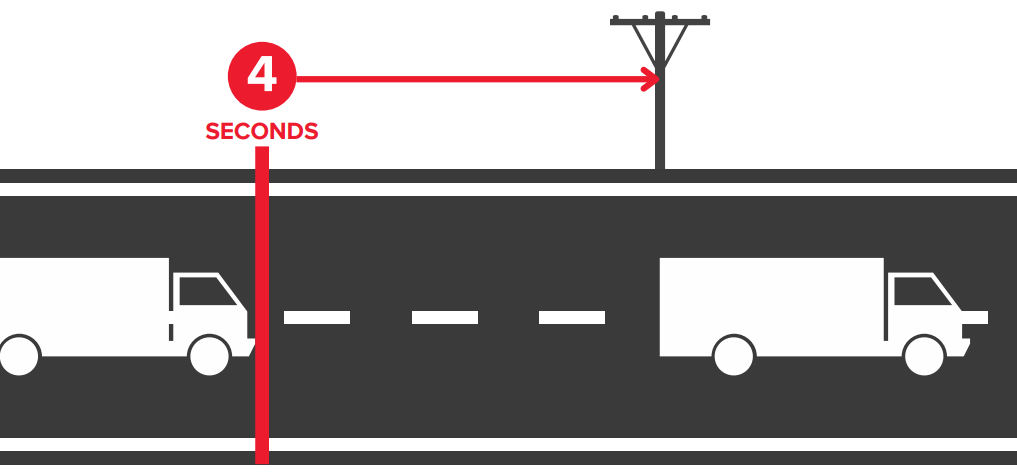What’s at Stake? Everything.
No matter what the vehicle – tractor-trailers, box trucks, flatbeds, dumps, work vans and even personal cars, you need to be sure your drivers are always operating company and personal vehicles safely, whether they are delivery goods, traveling between job sites, carrying passengers or simply a private driver of their own vehicle. Think about these statistics from Selective Insurance:
Many of these incidents occur during the workday or during the commute to and from work. Be sure safety is a top priority with your drivers and continually update them on safety tips to be safe at all times. These notices are a great reminder for them, in addition to their standard pre-trip inspections.

Understanding Proper Following Distance
To reduce the risk of driving into the rear of another vehicle it’s important to keep safety in mind. There are a few things drivers should do while operating a motor vehicle:
Potential for something to move into the crash avoidance space
Depending on circumstances, a four-second gap should be used for situations where there is potential for something to move into your crash avoidance space; for example, a car in another lane could swerve or misjudge passing space, a vehicle at an adjacent street could pull out without warning, and on any rural or highway situation, deer are an unknown risk we all encounter.
To determine the crash avoidance space to the front of the vehicle drivers need to consider two key factors – Reaction Time and Response Time.
Be sure you are demanding your drivers maintain a crash avoidance space completely around the vehicle by staying alert and adjusting speed and road position.
Reaction and Response Time
According to statistics, drivers who are fit, alert and concentrating, not affected by distractions or fatigue will still require one and a half seconds to perceive a hazard and another one and a half seconds to respond. This time can be even longer if a driver is under the influence of alcohol or drugs. This is important not just for your own drivers but others on the roads with them.
Reaction time is the time the driver needs to see the situation, process what it means, decide on a response, and instigate that response.
Response time is the time required to take action. Generally, a minimum of one and a half seconds is needed to respond.
The combined reaction and response time is what makes the three- to four-second rule and proper crash avoidance space so important. In many situations braking may be the only possible response. Swerving is rarely appropriate and can result in a more severe crash that could include even more vehicles.
Drivers may need even longer depending on speed, vehicle size and poor conditions such as weather or darkness.
Stopping Distance
Once a driver understands the time involved, they need to consider distance. Stopping distance is a combination of reaction distance and braking distance. Reaction distance is the distance that your vehicle travels from the time a driver perceives an issue that requires braking to when they actually move their foot to the brake pedal and begin to slow down. If a vehicle is too close to the vehicle in front, a collision is going to happen NO MATTER HOW GOOD THE DRIVER IS because a driver can only get to the brake as fast as a human can move. By the time the brake is deployed, if the vehicle in front is already braking hard, your driver doesn’t have a chance.
Conditions Requiring Increased Following Distance

Weather conditions: Rain, snow, high winds, or other weather problems

Road conditions: Gravel, broken up pavement, poor road markings, and steep grades

Lighting conditions: Nighttime darkness, oncoming vehicle lights, daytime sun glare

Traffic conditions: Heavy traffic, stop-and-go traffic, roadwork and changes in travel lanes

Driver condition: If your driver is fatigued, distracted or otherwise not 100 percent, reactions will not be as quick
Implement the Time Interval Formula for Following Another Vehicle
To instill the importance of following distance, talk to your drivers about ways they can calculate the appropriate crash avoidance space when following another vehicle. Review this basic time interval formula at your next driver safety meeting and urge your team to use it throughout the day.
While driving, select a fixed landmark like a power pole, tree or road sign. As the rear of the vehicle in front passes the object, start a count. ‘One thousand and one, one thousand and two, one thousand and three…’.

If the driver’s vehicle passes the object before the count is finished, they are too close, and the proper crash avoidance space is not large enough. Drivers then need to slow down and repeat the count again until the proper crash avoidance space is achieved. Be sure drivers are doing this intermittently, as conditions can change or deteriorate at any given time.
Your drivers are professionals, but even professionals need friendly reminders from time to time, so if you haven’t implemented driver safety meetings, it’s a great tool to keep safety top of mind for them. Download our STAY SAFE Infographic to hand out or post in your facility. Safe drivers are your greatest asset when it comes to collision avoidance.